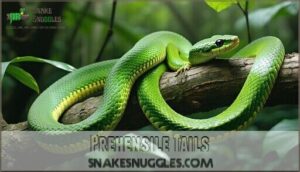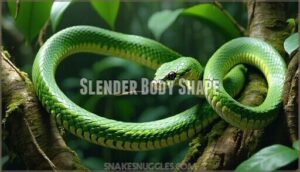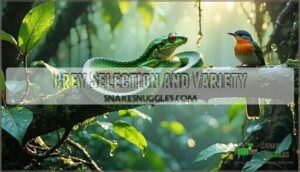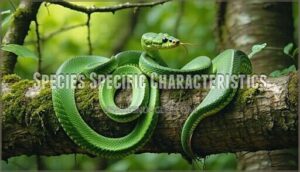This site is supported by our readers. We may earn a commission, at no cost to you, if you purchase through links.
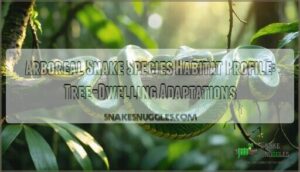
These serpents inhabit tropical forest canopies worldwide, using prehensile tails and slender bodies to navigate branches with remarkable precision.
Their ventral scales provide enhanced grip on bark surfaces, while their hunting strategies target birds, eggs, and small mammals that ground snakes can’t reach.
Species like green tree pythons and emerald boas showcase convergent evolution, developing similar heat-sensing pits and coiling techniques despite different evolutionary origins.
Their success depends on maintaining three-dimensional thinking in complex canopy environments where every movement requires calculated balance and timing.
Table Of Contents
- Key Takeaways
- Arboreal Snake Habitat
- Unique Anatomical Features
- Feeding Habits and Diet
- Species Specific Characteristics
- Conservation and Habitat Design
- Frequently Asked Questions (FAQs)
- Are rough green snakes arboreal?
- What pythons are arboreal?
- Are milk snakes semi-arboreal?
- How do arboreal snakes reproduce and breed?
- What temperatures do arboreal species require?
- How long do arboreal snakes typically live?
- Which arboreal snake species are best for beginners?
- Do arboreal snakes require special veterinary care?
- Conclusion
Key Takeaways
- You’ll discover that arboreal snakes have evolved remarkable physical adaptations like prehensile tails and specialized ventral scales that function as nature’s climbing gear, allowing them to navigate three-dimensional canopy environments with precision.
- You’ll find these tree-dwelling specialists occupy specific vertical zones within tropical rainforest canopies, creating a high-rise ecosystem where different species claim their preferred "floors" to reduce competition and maximize hunting success.
- You’ll notice that arboreal snakes are primarily nocturnal hunters who’ve mastered ambush techniques from above, using heat-sensing abilities and flexible striking platforms to target birds, small mammals, and other prey that ground snakes can’t reach.
- You’ll understand that habitat destruction and climate change pose serious threats to arboreal snake populations, making conservation efforts and proper captive habitat design crucial for maintaining these species’ survival in both wild and managed environments.
Arboreal Snake Habitat
You’ll find arboreal snakes thriving in tropical rainforests across Central America, Southeast Asia, Indonesia, and the Amazon, where dense canopy layers create perfect three-dimensional highways for these tree specialists.
These vertical ecosystems offer everything from ground-level shrubs to towering emergent trees, giving different snake species their own preferred "floors" in nature’s high-rise apartment building, with dense canopy layers and tropical rainforests providing ideal conditions.
Every tree level becomes a specialized apartment floor where different snake species claim their perfect vertical address.
Tropical Region Distribution
When you explore arboreal snakes’ tropical habitats, you’ll discover incredible species diversity across Central America, Indonesia, Southeast Asia, and the Amazon rainforest.
These forest habitats support over 300 snake species through vertical stratification and dense canopy structure.
Regional diets vary dramatically – climate impact shapes what’s available, from crickets in arid regions to abundant birds in humid tropical snakes territories, which is a key aspect of their species diversity.
Forest Canopy Structure
You’ll find that forest canopy structure directly impacts where arboreal snakes thrive.
Dense canopies create perfect hunting grounds with reduced light penetration, while vertical complexity offers multiple pathways for tree-dwelling snakes to navigate between branches.
Understanding the importance of canopy layers is key to snake habitat analysis.
Forest canopy characteristics that support arboreal species:
- Canopy Density – Thick leaf cover provides camouflage and hunting opportunities
- Light Penetration – Filtered sunlight creates ideal microclimates for temperature regulation
- Vertical Complexity – Multiple branch layers offer diverse perching and travel routes
- Species Diversity – Rich plant communities support varied prey populations
- Microclimates – Different humidity and temperature zones throughout canopy levels
Vertical Stratification
Within forest canopy layers, treedwelling snakes divide vertical space like apartments in a high-rise building.
Each floor offers different forest microclimates, light penetration levels, and resource availability.
You’ll notice species zonation patterns where arboreal species claim specific heights, such as mid-canopy branches where Green tree pythons prefer to reside.
Vine snakes hunt near the top where light filters through, demonstrating a unique snake habitat strategy that reduces competition and maximizes snake adaptations for survival.
Unique Anatomical Features
You’ll notice that arboreal snakes possess remarkable physical adaptations that make them masters of three-dimensional living.
Their prehensile tails function like an extra hand, wrapping around branches while their slender bodies slip through dense foliage with the grace of a ribbon in the wind.
Prehensile Tails
You’ll find that prehensile tails work like a fifth limb for tree-dwelling snakes.
These remarkable appendages use complex tail musculature to wrap around branches with incredible tail flexibility. The grasping mechanics allow arboreal snake species to anchor themselves while hunting or moving.
This anatomical adaptation provides evolutionary advantages, enabling secure arboreal locomotion through dense canopies. Snake adaptations like these prehensile tails make the difference between life and death in treetops, showcasing the importance of such anatomical adaptation.
Slender Body Shape
You’ll notice arboreal snake species possess remarkably slender bodies that function like nature’s perfect climbing tools.
These anatomical adaptations create reduced resistance when moving through dense foliage, allowing effortless movement between branches.
The elongated body shape enhances arboreal agility while supporting predator evasion through tight spaces.
Modified ovarian morphology prevents excessive body distension, maintaining streamlined snake morphology essential for foliage navigation and survival.
Their flexibility is enhanced by their elongated vertebral column, allowing for a greater range of motion, which is crucial for nature’s perfect climbing tools and overall survival.
Ventral Scale Adaptations
The ventral scales of arboreal snakes showcase remarkable snake morphology that’s perfectly suited for tree life.
These specialized belly scales create the surface grip needed for successful arboreal locomotion through several key anatomical adaptations:
- Enlarged scale size – bigger than terrestrial species for maximum contact
- Pronounced keels – ridged surfaces that dig into bark texture
- Overlapping arrangement – creates flexible gripping segments along the snake body structure
- Enhanced muscle attachment – stronger connections for climbing friction
This scale morphology provides the evolutionary advantage these serpents need to navigate vertical surfaces with confidence.
Feeding Habits and Diet
When you’re studying arboreal snakes, you’ll discover they’re primarily nocturnal hunters who’ve mastered the art of surprise attacks from above.
Their diet varies dramatically based on geographic location and available prey, ranging from birds and small mammals to insects and even other reptiles, which showcases their adaptability as hunters.
Nocturnal Hunting Behavior
Most arboreal snakes embrace the night shift, becoming nocturnal predators when darkness falls.
When darkness descends, tree-dwelling serpents transform into silent shadows, ruling their vertical kingdom with deadly precision.
They’ve mastered snake nocturnal behavior through specialized sensory adaptations that turn them into precision hunters.
Their activity patterns shift dramatically after sunset, allowing these tree-dwellers to dominate their vertical world through stealth and patience.
| Hunting Strategies | Key Features |
|---|---|
| Thermal Detection | Heat-sensing pits locate warm-blooded prey |
| Ambush Predation | Energy-efficient waiting reduces movement |
| Strike Precision | Prehensile tails provide stable striking platforms |
| Prey Detection | Enhanced olfaction tracks chemical trails |
These snake hunting techniques showcase remarkable snake behavior adaptations.
Reduced competition and improved stealth make nocturnal hunting incredibly effective.
Their snake habitat preferences align perfectly with nighttime activity, maximizing hunting success in the canopy’s three-dimensional maze.
Prey Selection and Variety
Beyond birds and small mammals, you’ll find these tree-dwelling hunters have surprisingly diverse prey preferences.
Over 60% of Amazon Basin emerald boas target arboreal rodents and passerine birds, while juveniles start with smaller prey like tree frogs before graduating to larger vertebrates.
Prey availability shapes their hunting strategies, with vine snakes opportunistically snatching geckos when birds aren’t around.
Environmental Influences on Diet
While prey selection matters, you’ll find that your tree-dwelling serpents can’t ignore environmental factors shaping their diet.
Forest complexity directly impacts what’s available on the menu, and habitat degradation reduces prey abundance by up to 35%. Climate impact and seasonal variation constantly reshape feeding ecology patterns.
A vital aspect involves understanding appropriate prey sizes to guarantee proper nutrition.
- Prey Abundance: Canopy complexity and tree species richness determine available food sources for regional differences in diet
- Seasonal Variation: Rainfall patterns and climate cycles affect invertebrate and vertebrate populations throughout the year
- Habitat Degradation: Deforestation fragments ecosystems, reducing prey biomass and altering natural feeding behaviors substantially
- Regional Differences: Local prey preferences adapt to specific canopy structures and available food webs in different habitats
Species Specific Characteristics
You’ll discover that each arboreal snake species has evolved unique traits perfectly suited to their specific forest environments.
From the vibrant green camouflage of tree pythons to the incredible flexibility of vine snakes, these adaptations reveal nature’s remarkable ability to customize solutions for life in the trees, showcasing remarkable ability to thrive.
Green Tree Python Traits
You’ll find Green Tree Python adaptations fascinating in their arboreal habitat.
These pythons showcase remarkable Size Variation, averaging 1.5-2.0 meters with striking Color Morphs from vivid green to yellow-striped juveniles.
Their Origin Regions span New Guinea rainforests and northern Australia’s canopies.
Green Tree Python behavior includes coiled resting postures using prehensile tails for support.
Captive Care requires understanding their docile Temperament and specialized climbing needs for proper husbandry.
Amazon Basin Emerald Boa Features
You’ll discover the Amazon Basin Emerald Boa’s remarkable adaptations make it a true tree boa specialist.
These South American Habitat natives showcase brilliant emerald coloration with distinctive white vertebral stripes, perfectly suited for tropical rainforests.
Key Emerald Boa features include:
- Emerald Boa Size: Adults reach impressive 2.1-meter lengths with robust, muscular builds
- Arboreal Adaptations: Powerful prehensile tails and broad bodies enable expert tree navigation
- Emerald Boa Diet: Nocturnal ambush predators targeting birds and mammals in dense canopy
Their viviparous reproduction sets them apart from egg-laying snake species in similar snake habitats.
Asian Vine Snake Characteristics
Moving from the broad-bodied Amazon emerald boa, you’ll encounter the Asian vine snake‘s slender frame measuring 1-1.8 meters.
This tree-dwelling serpent showcases remarkable snake species characteristics through its laterally compressed body and forward-facing eyes. Captive breeding programs focus on maintaining their cryptic green snake species color variations.
Their locomotion methods involve bending their bodies in smooth curves.
| Feature | Description | Function |
|---|---|---|
| Body Shape | Laterally compressed, elongated | Enhanced reach among branches |
| Vision | Large horizontal pupils, binocular | Precise prey detection |
| Coloration | Cryptic green matching foliage | Perfect camouflage system |
| Locomotion Style | Rapid striking, flexible movement | Effective arboreal hunting |
Their snake species size allows incredible flexibility when traversing tight spaces. Snake species behavior includes ambush tactics targeting lizards and frogs.
Vine snake care requires understanding their temperament issues and specialized arboreal needs.
Conservation and Habitat Design
You’re witnessing arboreal snake populations face serious threats from habitat destruction and climate change, making conservation efforts more critical than ever.
Creating proper captive environments requires understanding their natural needs, from vertical space requirements to climbing structures that mimic their forest homes, which is crucial for their survival and involves conservation efforts.
Threats to Arboreal Snakes
Arboreal snake populations face mounting pressures from deforestation, which has reduced tropical habitats by 30% over two decades.
Climate change shifts suitable zones northward, while urbanization fragments forest canopies.
Habitat destruction and ecosystem degradation create isolated populations with 15% higher extinction risks, and unfortunately, many species remain classified as Data Deficient, hampering conservation efforts.
Habitat Preservation Efforts
Conservation efforts show real promise for tree-dwelling serpents.
Protected areas now cover 25% of critical habitats, while reforestation impact studies reveal an 18% increase in snake sightings over five years.
Community education programs boost local support by 60%, and funding initiatives enable habitat preservation projects.
Creating a snake friendly environment can further aid conservation efforts.
These forest ecosystems support biodiversity benefits that extend far beyond individual species conservation.
Designing Suitable Captive Environments
You’ll need to recreate their natural treetop world to keep your tree-dwelling serpents healthy and happy.
Proper habitat design transforms a basic snake enclosure into a thriving ecosystem that encourages natural behaviors.
- Enclosure size: Choose vertical tanks at least 1.5-2x your snake’s length
- Temperature gradient: Maintain 24-30°C with climbing structures for thermoregulation
- Humidity levels: Keep above 70% using automated misting systems
- Lighting needs: Provide natural day/night cycles with non-reflective surfaces
- Substrate choice: Use textured materials that prevent scale abrasions while supporting natural foliage
When planning, consider specialized snake supplies for superior care.
Frequently Asked Questions (FAQs)
Are rough green snakes arboreal?
Yes, you’ll find rough green snakes are completely arboreal.
They spend their entire lives in trees and shrubs, using their slender bodies and excellent climbing abilities to navigate branches while hunting insects and small prey.
What pythons are arboreal?
Absolutely mind-blowing diversity awaits you! Green tree pythons from Australia and Indonesia dominate canopies, while carpet pythons also climb trees. You’ll find these magnificent serpents thriving in tropical rainforests worldwide.
Are milk snakes semi-arboreal?
Milk snakes climb trees occasionally but aren’t truly semi-arboreal.
They’re primarily terrestrial, spending most time on the ground hunting rodents, though they’ll climb when searching for bird eggs or escaping threats.
How do arboreal snakes reproduce and breed?
Arboreal snakes reproduce through internal fertilization, with males using specialized reproductive organs called hemipenes. Females lay eggs in tree hollows or give birth to live young, depending on species.
What temperatures do arboreal species require?
Like a cozy blanket wrapped around a tree, you’ll need to maintain temperatures between 75-85°F for most arboreal snakes.
With nighttime drops to 70-75°F creating natural thermal gradients they’d experience in wild canopies.
How long do arboreal snakes typically live?
Most arboreal snakes you’ll encounter live 15-20 years in captivity with proper care.
Green tree pythons can exceed 30 years, while species like emerald tree boas maintain similar lifespans when you provide appropriate husbandry and environmental conditions.
Which arboreal snake species are best for beginners?
Beginner-friendly breeds bring joy without overwhelming challenges. You’ll find success with kenyan sand boas, offering docile temperaments, manageable sizes, and straightforward care requirements for first-time arboreal snake owners.
Do arboreal snakes require special veterinary care?
You’ll need specialized veterinary care for your arboreal snake, including exotic-animal vets experienced with reptiles. These specialists understand unique health issues like respiratory infections and parasites common in tree-dwelling species.
Conclusion
Remarkably resilient reptiles, arboreal snake species have mastered their elevated environments through millions of years of evolution.
Understanding each arboreal snake species habitat profile reveals nature’s incredible adaptability in vertical ecosystems.
You’ll discover that these tree-dwelling specialists continue adapting to changing forest conditions, making their conservation essential for maintaining biodiversity.
Their unique anatomical features and behavioral patterns offer valuable insights into evolutionary biology while highlighting the importance of preserving tropical canopy habitats for future generations.

